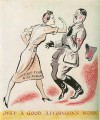Propaganda posters produced in Britain during the Second World War serve as important visual source material for historians. The images themselves provide a valuable social and, to a lesser extent, also artistic commentary on life in Britain during the early 1940s. The posters are also instructive in political terms. The choice of subject matter indicates the priorities and preoccupations of those on whose behalf they were produced, which was, in most cases, the wartime Government.
The co-ordination of domestic propaganda in Britain during the Second World War was carried out mainly by the Ministry of Information, established at the outbreak of war in 1939. Its prime purpose was to sustain civilian morale and its functions included the production of propaganda posters both for itself and for other branches of Government. These “weapons on the wall”, as they were sometimes known, had the advantage of being cheap to produce and easy to distribute.
Posters were not the totality of Government wartime propaganda in Britain. They were often used as part of a coordinated campaign together with films, radio broadcasts, pamphlets, and articles and advertisements in newspapers and magazines. The most powerful mass medium of our contemporary society – television – was not, of course, available during the Second World War.
Propaganda posters were designed for a variety of locations, some for external display on street hoardings, others for display inside shops, pubs, factories and offices. But, wherever displayed, in order to be effective, posters had to achieve three main objectives – they first had to attract the attention of those passing by; having done so they had to communicate their message clearly; and lastly that message had to imprint itself on the memory.
The posters selected for this Detailed Study have been divided into six key themes. The themes are not mutually exclusive and some posters relate to more than one category. Other posters fall outside the main themes and are located in a seventh, miscellaneous section.
The government went to great lengths to ensure people had enough to eat, so they were fit to face wartime challenges and contribute to the fight. Plans for rationing and distribution were drawn up with this in mind.
The ‘Dig for Victory’ campaign saw people turn their flowerbeds into vegetable patches. The aim was to make Britain as self sufficient in food as possible. Chickens, rabbits and even pigs were reared in town gardens. As more and more supply ships were being sunk by the German U-boats, additional home grown food was needed. All able-bodied men were needed to fight, leaving a shortage of labour to work on farms. The Women’s Land Army provided much of the labour force required.
The girls of the Land Army looked after animals, ploughed the fields, dug up potatoes, harvested the crops, killed the rats, dug and hoed for 48 hours a week in the winter and 50 hours a week in the summer. As there was not enough machinery to go round, they often had to work with old fashioned equipment, such as horse drawn hand ploughs, and to harvest crops by hand.Apple peel was boiled to make a lemon substitute in jams or drinks; bacon rinds provided fats for cooking meat or were used for flavouring soups; stale bread went into puddings or to make stuffing. Other scraps fed the animals.
Lord Woolton held this important job from April 1940 to December 1943.Lord Woolton had seen the effects of malnutrition in Liverpool and was determined to improve the nutritional value of people’s diet to overcome this. The resulting food policy promoted both adequate nourishment and economical use of available foods.It was the first time the findings of nutritional science, built up since WW1, were applied to feeding the population. Lord Woolton ran a very successful campaign and his famous Woolton pie became legendary! Lord Woolton had seen the effects of malnutrition in Liverpool and was determined to improve the nutritional value of people’s diet to overcome this. The resulting food policy promoted both adequate nourishment and economical use of available foods.
|
||||||
British Propaganda Posters WW2 |
||||||
|
Copyright © 2024 weirdcorner-best weird and funny photos,videos and articles - All Rights Reserved |
||||||
































































Opinions